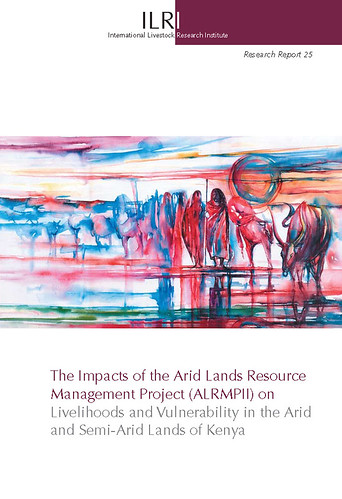The cover of a 2011 ILRI report that evaluated a long-term drought management project–the Arid Lands Resource Management Project–in Kenya (photo credit: ILRI).
The current drought in the Horn of Africa is once more stressing the urgent need to invest in agricultural development in the region. Adopting new approaches for drylands agriculture, increasing support for agricultural research and better cooperation between partners will help farmers and herders in these areas to cope with increasingly harsh climates and improve their food production.
A 2011 report of an evaluation of a long-term drought management initiative in Kenya’s arid and semi-arid lands (ASALs) indicates that long-term interventions in Africa’s drylands can lower the levels of vulnerability to drought and reduce the need for food aid. Such initiatives help speed emergency responses, improve food security, empower locals to influence policies and promote often-neglected drylands issues at national levels.
This review is of the second phase of a project known as ‘Impacts of the Arid Lands Resource Management Project (ALRMPII).’ It was carried out by the International Livestock Research Institute (ILRI) to assess the project’s impact on livelihoods and vulnerability in 10 arid and semi-arid districts in Kenya. The ALRMPII is a community-based drought management initiative that was implemented by the Government of Kenya with support from the World Bank in 28 districts.
The first phase of this project concentrated on improving drought management, marketing, infrastructure and community development in 10 of Kenya’s arid districts over seven years (1996–2003). The project increased the response capacity of herders during the 1999 and 2001 droughts, implemented over 1000 micro projects that benefited over 180,000 people, created grazing reserves for pastoralists in 24 areas and supported initiatives to reduce land degradation. Following these successes, the project’s second phase or ALRMPII, started and was expanded to include semi-arid regions of the country with the aim of enhancing food security, increasing access to basic services, and reducing livelihood vulnerability in 28 drought-prone ASAL districts. This second phase of the project was carried out between 2003 and 2010.
ILRI’s evaluation of ALRMPII reviewed activities in Garissa, Kajiado, Laikipia, Mandera, Marsabit, Mwingi, Narok, Nyeri, Tharaka and Turkana districts using household surveys, focus group discussions and interviews with relief and development agencies in the districts as well as people involved in policy processes in Nairobi.
The review assessed the project’s key performance indicators, which were:
- Decreasing the number of people needing free food aid
- Reducing emergency response times
- Improving child nutrition
- Increasing access to water, health, education and other social services
- Strengthening local people’s contribution to policymaking
The review found that in arid areas, herders felt it ‘difficult to abandon pastoralism,’ which was the only suitable form of livelihood in these areas. In the semi-arid districts, on the other hand, communities were more likely to be settled because mixed crop-livestock farming was allowing them to diversify their livelihoods. As a result, many households in the semi-arid districts were increasingly relying on agriculture, and a growing cash economy enabled some herders to hire labour to manage their animals.
The report, by ILRI’s Ayago Wambile and Nancy Johnson, interestingly found that while according to local indicators long-term interventions were effectively decreasing livestock losses in arid districts, food aid needs in those districts were increasing. The authors conjectured that increasing need for food aid could have resulted from prolonged dry seasons, which make it harder for households to re-build their herds and from increases in resource-based conflict.
The report points out that although the arid areas had shown an increased demand for food aid, investment from Government through this project was lowering these needs. In the arid districts, ‘ALRMPII expenditure is negatively and significantly associated with the percent of people needing food aid,’ which means that as expenditure—a proxy for the intensity of project activity—increased the number of people needing aid declined.
Also, the review suggests, the project bulletin had ‘become the most useful and most used source of early warning information for response agencies.’ Users of the bulletin also felt emergency responses were faster, better coordinated, and more appropriate, a claim that was supported by data on response times. The review shows that ALRMPII appears to have improved child nutrition and provided a ‘nutritional safety net’ in participating communities. Further, the project enabled local people to participate in policymaking. Key stakeholders from these regions were invited to take part in ASALs policymaking processes where they ‘contributed evidence and experience.’ (However, while access to social services did increase in the ALRMP study communities, this cannot be attributed to the project since it also increased in control communities).
Even though the changes observed in these areas during the review may not all have resulted from ALRMPII–mobile phone coverage, rapid responses by relief agencies and international funding for emergency responses all increased during this period–this review found that the project did make a difference. But even with the successes of ALRMPII, challenges such as conflict are still a threat to livelihoods in much of the region. Regarding repeated environmental shocks on households, the review recommends focusing ‘on interventions that go beyond current drought to address issues such as conflict or dependency.’
Finally, it recommends that future ALMPII reviews be expanded to cover impacts of the project on the environment, capacity building, community empowerment and overall risk management coordination in these regions.
—
Download the complete report: https://cgspace.cgiar.org/bitstream/handle/10568/3416/9291462578_content.pdf?sequence=1

